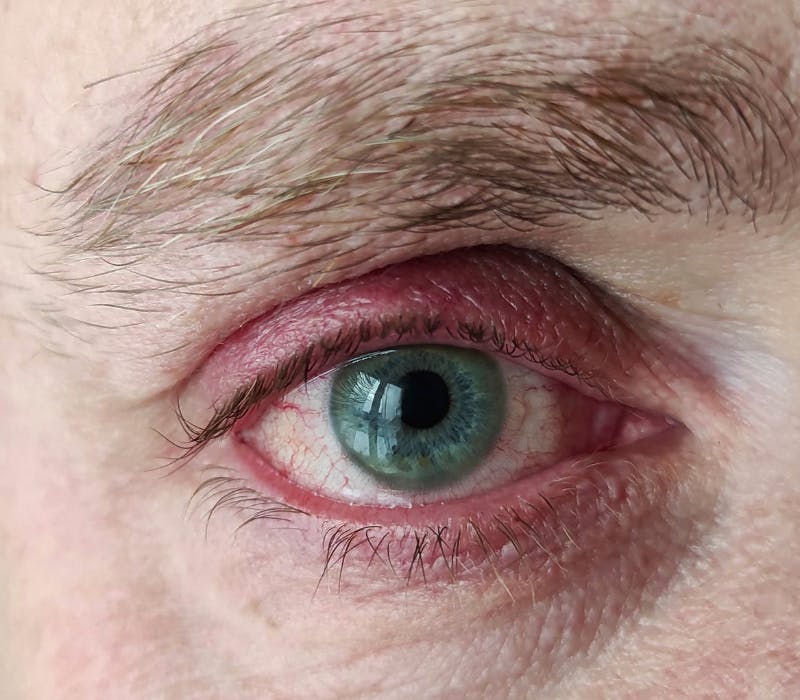
Your eyes play a major role in your ability to live a normal life, but many people don’t give their eyelids and eyelashes enough credit for that feat. In fact, they’re just as important to your eye health and overall vision, which means they deserve just as much attention as the eye itself.
Without proper functioning of your eyes and eyelids, individuals can experience a wide range of unwanted health problems and life complications. That’s why a regular visit to your eye doctor -- such as Dr. Omar Shakir -- is so important to maintaining a healthy and fulfilling lifestyle.
Something that’s more common than you’d think is swollen eyelids and flaky crusts forming around the edges of the eyelid. If this sounds like something you’re experiencing, you should contact Dr. Omar Shakir immediately because these are common symptoms of blepharitis.
So, What Is Blepharitis?
Blepharitis is a chronic skin condition characterized by inflammation of the eyelids. Many doctors refer to this as marginal blepharitis, since it impacts the margins of the eyelid where the eyelid opens. Most individuals will experience blepharitis at least once in their lifetime.
While it’s not contagious and won’t result in permanent damage to the eyesight or vision, the eyelid inflammation can result in irritation, itching, and redness of the eyelids. Some people might experience a burning sensation of the eyelids. It affects around 15-25% of the population.
Anyone living with blepharitis should contact their trusted eye care provider immediately for an eye exam. It normally means there’s a larger issue that needs to be detected, diagnosed, and treated. If not treated properly and in a timely manner, blepharitis can take a turn for the worse.
What Causes Blepharitis of the Eye?
A majority of blepharitis cases are caused by eyelid inflammation or dysfunction of the oil glands found on the interior or exterior of the eyelids themselves. When the glands in your eyelids aren’t functioning properly, it’ll cause bacteria to build up and produce toxins that affect tear production.
While bacteria is found all throughout the body -- including the eyelids -- too much bacteria can cause major issues, such as blepharitis. Since this can impact the tears that are tasked with coating the surface of the eye, blepharitis that’s untreated can cause dry eyes in the individual.
In addition to the inflammation of the eyelids and dysfunction of oil glands in your eyelids, blepharitis can be caused by a wide range of other things -- such as aging, hormones, genetics, and wearing contact lenses, which many individuals use daily.
Those that stare at a computer screen for large periods of time throughout the day are also more prone to blepharitis, especially when sitting in an air-conditioned room or office. This is why eye exams that are comprehensive are important to help reduce the chances of Blepharitis before it worsens.
Types of Blepharitis
If you’ve ever visited your ophthalmologist for blepharitis, you’ve likely heard them mention two different types or classifications of blepharitis -- anterior blepharitis or posterior blepharitis. This is generally based on where the blepharitis is found and what the general cause is for blepharitis.
With anterior blepharitis, you’re experiencing inflammation of the eyelash or hair follicles. It’ll generally look like oily flakes or crusts forming at the base of your eyelash -- similar to the dandruff found in your hair. It’s not always easy to see with the naked eye, but they are present.
With posterior blepharitis, you’re experiencing inflammation of the inside of your eyelid. This generally involves the meibomian glands, which run along the inside of the bottom and top of your eyelid. When not functioning properly, your tears evaporate instantly and cause dry eyes.
Are There Ways to Treat Blepharitis?
As dangerous as blepharitis is, it’s an eye problem that’s very easy to treat and can easily be prevented with regular eyelid hygiene. This is something every individual -- adults and children -- should be doing on a daily basis to prevent the buildup or spread of bacteria around the eyelid.
Two of the best ways to clean your eyelids are with warm compresses or eyelid scrubs. With warm compresses, all you’ll need is a clean washcloth dampened by warm water. Apply the washcloth to your eyelid to reduce the inflammation of the oil glands in your eyelids.
Eyelid scrubs are designed to wash away bacteria, oil, and the dandruff-like crusts that form on the base of your eyelashes. It’s one of the best types of blepharitis treatment, but is also important in blepharitis prevention. It should be applied to the closed eyelid for two minutes.
With children, you should consider making this a part of their bath time routine, especially since it’s more difficult to clean the eyelids of children. With less bacteria buildup around the eyelash, the secretion will be able to flow properly onto the ocular surface, slowing down tear evaporation.
Complications of Blepharitis
Those with blepharitis should take the daily warm compresses and eyelid scrubbing seriously, but there might come a time when the blepharitis is difficult to manage. In fact, it can cause complications and further eye problems that begin to impede your ability to live a happy life.
For example, blepharitis can cause your eyelashes to fall out, lose color, or grow abnormally. It can also cause scarring of the eyelids, excess tearing, a stye, a chalazion, chronic pink eye, and even injury to the cornea. The most common complication of blepharitis is dry eye disease.
When Should You Visit Your Ophthalmologist?
If you feel your blepharitis is only worsening over time, you should contact your trusted eye care provider immediately. Daily and regular cleaning of the eyelid should be enough to prevent these issues, so there’s likely something larger in play that your eye doctor can find a treatment for.
To ensure you receive the blepharitis treatment that’s best-suited for you, don’t hesitate to reach out to Dr. Omar Shakir at Coastal Eye Surgeons. He’s licensed and experienced to treat a wide range of eyelid and eyelash problems and would love the opportunity to serve you and your family.
Even if you’re not suffering from blepharitis or don’t notice any oily crusts forming on your eyelashes, now is a perfect time to schedule an appointment for a necessary comprehensive eye exam -- that way, you can prevent any future eye conditions from wreaking havoc on your life.
Check out our article on How to Get Rid Of a Stye Safely & Properly

